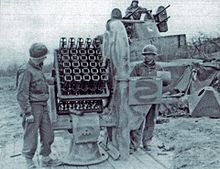Henschel Hs 297
The Henschel Hs 297 Föhn was a German mini anti-aircraft missile used in World War II.
In principle, the Hs 297 is similar to the Fliegerfaust , but with the difference that the Hs 297 was not designed as a shoulder weapon. With both weapon systems, several small-caliber, uncontrolled rockets should be used against low-flying aircraft.
The rockets had a caliber of 7.29 cm, a length of 29.5 cm and a weight of 2.7 kg. The launch took place from simply constructed racks that could hold 35 missiles (5 × 7) and from which several missiles were fired at the same time. Individual starts were also possible. The range of the missiles was 1200 meters. The throwers were aimed directly by means of a hovering semicircle sight. The warhead used was filled with 280 g RDX / TNT and had an impact fuse with a self-destructing device.
The device was intended as a so-called Volks-Fla-R launcher for mass use in the Volkssturm . By February 1945, 50 devices had been delivered that were intended for troop trials. 24 of these launchers went into position with the 3. / FlakLehruVersAbt 900 (o) in the Remagen area and were used there for the first time on March 2, 1945 against Allied fighter-bombers . A few days later, after the Ludendorff Bridge near Remagen was captured , some of the classified throwers fell undamaged into the hands of the Americans. As early as January 1945, six launchers were installed in the port area of the island of Helgoland , but nothing is known about their use.
Henschel Hs 297 hair dryer in the Swedish Army Museum in Stockholm
Individual evidence
- ↑ Lothar Brüne, Jakob Weiler: Remagen in March 1945 - A documentation on the final phase of the Second World War. Peace Museum “Bridge of Remagen e. V. “(Ed.), Remagen 1993, ISBN 3-9803385-9-2 , p. 68 f.
- ↑ Claude Fröhle, Hans-Jürgen Kühn: Hochseefestung Helgoland - A military-historical journey of discovery. Part II, Fröhle-Kühn Verlagsgesellschaft, Herbolzheim 2001, ISBN 3-9805415-3-3 , p. 64.
- ↑ Lothar Brüne, Jakob Weiler (Ed.), P. 30 and 206 ff.
- ↑ Claude Fröhle, Hans-Jürgen Kühn (ibid.): Pp. 63 f and 75.


